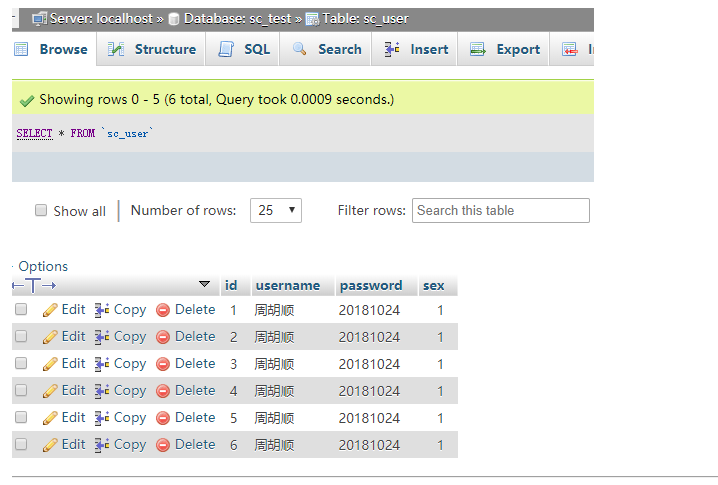1、编写实体Bean
package test.z.mybatis.beans;
import
java.io.Serializable;
public class TestBean implements Serializable{
private Integer id;
private String username;
private String
password;
private Integer sex;
public TestBean() {
super();
}
public TestBean(String username,String password,int
sex) {
this.username=username;
this.password=password;
this.sex=sex;
}
}
并在mybatis.cfg.xml中加入相关配置
<typeAliases >
<!-- 别名方式1,一个一个的配置 type中放置的是类的全路径,alias中放置的是类别名
<typeAliase
type="test.z.mybatis.beans.TestBean" alias="UserBean"/> -->
<!-- 别名方式2,自动扫描,将JAVA类的类名作为类的类别名 -->
<package
name="test.z.mybatis.beans"/>
</typeAliases>
2、编写Mapper
package test.z.mybatis.mapper;
import
test.z.mybatis.beans.TestBean;
public interface TestMapper {
public int
insertUser(TestBean tb) throws Exception;
}
并在mybatis.cfg.xml中加入相关配置
<mappers>
<!-- 告知映射文件方式1,一个一个的配置-->
<mapper resource="test/z/mybatis/mapper/TestMapper.xml"/>
<!-- 告知映射文件方式2,自动扫描包内的Mapper接口与配置文件
<package
name="test/z/mybatis/mapper"/> -->
</mappers>
3、编写Mapper配置
<?xml version="1.0" encoding="UTF-8"?>
<!DOCTYPE mapper PUBLIC
"-//mybatis.org/DTD Mapper 3.0" "http://mybatis.org/dtd/mybatis-3-mapper.dtd">
<mapper
namespace="test.z.mybatis.mapper.TestMapper">
<!-- 自定义返回结果集
-->
<resultMap id="userMap" type="TestBean">
<id property="id" column="id"
javaType="java.lang.Integer"></id>
<result
property="username" column="username"
javaType="java.lang.String"></result>
<result
property="password" column="password"
javaType="java.lang.String"></result>
<result
property="sex" column="sex"
javaType="java.lang.Integer"></result>
</resultMap>
<!-- 在各种标签中的id属性必须和接口中的方法名相同 ,
id属性值必须是唯一的,不能够重复使用。parameterType属性指明查询时使用的参数类型,resultType属性指明查询返回的结果集类型-->
<!-- useGeneratedKeys:( 仅 对 insert 有 用 ) 这 会 告 诉 MyBatis 使 用 JDBC
的getGeneratedKeys
方法来取出由数据(比如:像 MySQL 和 SQLServer
这样的数据库管理系统的自动递增字段)内部生成的主键。默认值: false。 -->
<!--keyProperty: (仅对
insert有用)标记一个属性, MyBatis 会通过 getGeneratedKeys或者通过 insert 语句的 selectKey
子元素设置它的值。默认:不设置。 -->
<!--#{}中的内容,为占位符,当参数为某个JavaBean时,表示放置该Bean对象的属性值
-->
<insert id="insertUser" useGeneratedKeys="true"
keyProperty="id">
insert into sc_user (username,password,sex)
values (#{username},#{password},#{sex})
</insert>
<update id="updateUser" >
update sc_user set
username=#{username},password=#{password},sex=#{account} where id=#{id}
</update>
<delete id="deleteUser"
parameterType="int">
delete from sc_user where id=#{id}
</delete>
<select id="selectUserById"
parameterType="int" resultMap="userMap">
select * from sc_user where
id=#{id}
</select>
<select id="selectAllUser"
resultMap="userMap">
select * from sc_user
</select>
</mapper>
4、编写Model ,model 必须继承于BModel
package test.z.model;
import
org.jkas.core.BModel;
public class TestBM extends BModel{
}
5、编写控制器
package test.z.app;
import
test.z.mybatis.mapper.TestMapper;
import
test.z.mybatis.beans.TestBean;
import test.z.model.TestBM;
public class
Mbts extends FrontBase
{ public void index()
{ TestBM tb=new
TestBM();
TestMapper tm=tb.getMapper(TestMapper.class);
TestBean test = new TestBean("周胡顺", "20181024", 1);
try
{
tm.insertUser(test);
tb.commit();
}
catch (Exception
e)
{ tb.rollback();
echo(e.toString());
}
finally
{tb.close();//必须调用关闭连接
}
echo("ok");
}
}
使用结束 必须调用.close()关闭会话,否则会导致连接没有关闭问题!
执行结果 :
